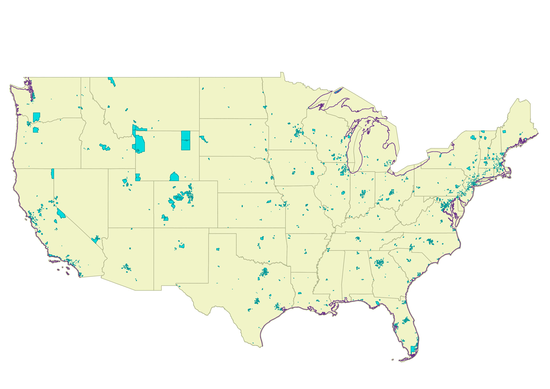Walkability via Census |
August 18th, 2014 |
| geography, maps, transit |

This is pretty cool! But let's have a look at these correlations:
| % 16 and older employed in civilian labor force | 0.636261 |
| % 25-34 years old | 0.630423 |
| % females 16 and older employed in civilian labor force | 0.594394 |
| % 16 and older in civilian labor force | 0.578812 |
| Nonrelatives in household | 0.561472 |
| % 16 and older in labor force | 0.545052 |
| % 16 and older commuting to work by other means | 0.542523 |
| % females 16 and older in civilian labor force | 0.532800 |
| % 18 years and younger | 0.530061 |
| % born in state of residence | -0.529451 |
| houses built 1939 or earlier | 0.528639 |
| workers 16 and older commuting to work by other means | 0.527117 |
| workers 16 and older walking to work | 0.525601 |
| % females 16 and older in labor force | 0.522900 |
| % with at least a bachelors degree | 0.522021 |
| % 10-14 years old | -0.519463 |
| % 16 and older driving to work alone | -0.507589 |
| population 25-34 years old | 0.507211 |
| % 16 and older not in labor force | -0.502902 |
- employment
- % 16 and older in labor force
- % 16 and older in civilian labor force
- % 16 and older employed in civilian labor force
- % 16 and older not in labor force
- % females 16 and older in labor force
- % females 16 and older in civilian labor force
- % females 16 and older employed in civilian labor force
- population, after considering %-version of the same metric
- population 25-34 years old
- workers 16 and older commuting to work by other means
- age
- % 10-14 years old
- % 18 years and younger
- % 25-34 years old
- population 25-34 years old
- commuting
- % 16 and older driving to work alone
- workers 16 and older walking to work
- % 16 and older commuting to work by other means
- workers 16 and older commuting to work by other means
| % 16 and older employed in civilian labor force | 0.636261 |
| % 25-34 years old | 0.630423 |
| Nonrelatives in household | 0.561472 |
| % born in state of residence | -0.529451 |
| houses built 1939 or earlier | 0.528639 |
| workers 16 and older walking to work | 0.525601 |
| % with at least a bachelors degree | 0.522021 |
This actually surprises the author somewhat; after taking affordability into account and seeing what places had the best combination of walkability and affordabilty by their metric they wrote:
I was expecting something like a smaller, affordable Midwest town or something, but it the highest scoring areas were usually just outside of major downtownIt looks to me like what's going on is that the kind of people who want to live in the walkable parts of DC are not the kind of people who want to live in smaller Midwest towns, even if those towns are super walkable.
(On the other hand, this might actually be a better metric for the author's purposes. They're really trying to figure out where they would enjoy living, and they think they want walkable neighborhoods. But having a lot of people 25-35 and a lot of strangers living together, along with high employment and education, are probably also things they care about. A retirement community in rural Tennessee might be both very walkable but it's probably not what they had in mind.)
Comment via: google plus, facebook, substack